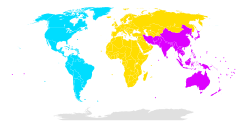Space telecommunication service
The space telecontrol radio service ( English space Operation Service ) is as defined by the ITU Radio Regulations (Radio Regulations) of the International Telecommunication Union (ITU) a radio service , which serves exclusively for the operation of space vehicles, in particular the space tracking , the space measurement and the space remote control .
Frequency ranges
This radio service is available in ITU region 1 and in particular on German territory u. a. the following frequency ranges are available.
| Assignment to radio services according to VO radio | ||||
|---|---|---|---|---|
| Germany | Users | comment | ||
| Frequency ranges MHz | ||||
| 184 | 30.005-30.01 | SPACE RADIO SERVICE | civil, mil. | civil - civil users mil - military users Footnotes: 5 31 |
| 206 to 208 | 137-138 | SPACE RADIO SERVICE | civil. | 5 31 |
| 213 | 148-149.9 | SPACE RADIO SERVICE | civil. | 3 5 31 |
| 228 | 227-273 | SPACE RADIO COMMUNICATION 13 | mil. | D254 5 31 |
| 239 | 400.15-401 | Space telecontrol service (direction space - earth) |
civil. | 5 31 |
| 240 | 401-402 | SPACE REMOTE RADIO SERVICE (direction space - earth) |
civil. | 5 31 |
| 262 | 1,427-1,429 | SPACE REMOTE RADIO SERVICE (direction space - earth) |
civil, mil. | D338A 5 31 |
| 267 and 268 | 1,525-1,535 | SPACE REMOTE RADIO SERVICE (direction space - earth) |
civil. | D351 5 31 |
| 294 | 2,025-2,110 | Space telecontrol service (direction space - earth) |
civil, mil. | 5 31 |
| 298 | 2,200-2,290 | Space telecontrol service (direction space - earth) |
civil, mil. | 5 31 |
Web links
Individual evidence
- ↑ VO Funk, 2012 edition, Article 1.23
- ↑ Uppercase : primary assignment
- ↑ Footnote 5 : ISM applications can also use frequency ranges that are assigned to radio services in the frequency range 9 kHz - 300 GHz if the frequencies required for this use are specified due to the desired physical effect and cannot be freely selected. The limit values of the permissible radiation and other parameters relevant to interference for these ISM applications are specified in the required frequency allocation from the point of view of radio compatibility. The ISM usage according to this usage provision must not cause any interference with other radio systems and radio services currently and in the future. The shared use of frequencies by ISM applications in frequency ranges that are dedicated to safety-relevant radio applications is excluded.
- ↑ Footnote 31 : The frequency ranges above 30 MHz can also be used by radio systems with the lowest power. When selecting the frequency ranges, the increased protection requirements of safety-relevant radio applications must be guaranteed. The frequency ranges, limit values of the permissible radiated power and other interference-relevant parameters of radio systems with the lowest power are specified in the frequency plan or the required frequency allocation . Low-power radio systems must not cause any interference in other radio systems and radio services currently and in the future to which the corresponding frequency ranges are assigned on a primary or secondary basis . Interference from these other radio systems and radio services must be accepted by radio systems with the lowest power.
- ↑ Footnote 3 : In the frequency ranges 9 - 14 kHz, 72 - 112 kHz, 115 - 126 kHz, 3 500 - 3 800 kHz, 4 063 - 4 438 kHz, 5 900 - 6 525 kHz, 300 - 7 350 kHz, 8 195 - 8 815 kHz, 9 400 - 9 900 kHz, 11 600 - 11 650 kHz, 12 050 - 12 100 kHz, 12 330 - 1 200 kHz, 13 570 - 13 600 kHz, 13 800 - 13 870 kHz, 15 600 - 15 800 kHz, 16 460 - 17 360 kHz, 17 480 - 17 550 kHz, 18 900 - 19 020 kHz, 22 000 - 22 720 kHz, 25 070 - 25 110 kHz, 26 100– 26 175 kHz, 28 000 - 29 700 kHz, 34.35 - 36.55 MHz, 38.45 - 39 MHz, 137 - 138 MHz, 144 - 223 MHz, 410 - 862 MHz, 1 525 - 1 535 MHz, 1 660.5 - 1 700 MHz , 2 290 - 2 300 MHz, 3 400 - 3 600 MHz, 5 150 - 5 255 MHz, 5 850 - 6 525 MHz, 14 - 14.62 GHz, 15.23 - 15.35 GHz, 17.3 - 17 , 7 GHz, 23 - 23.6 GHz, 31 - 31.3 GHz and 66 - 71 GHz, individual frequencies are used for military purposes.
- ↑ Footnote D254 : Frequency ranges 235 - 322 MHz and 335.4 - 399.9 MHz may be used by the mobile radio service via satellites on the condition that radio stations of this service at radio stations of other services that work in accordance with the frequency allocation table or their operation in accordance with with the frequency allocation table planned, do not cause interference.
